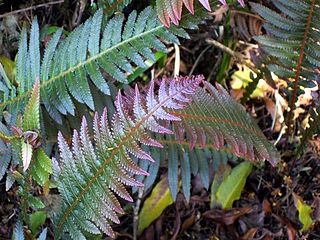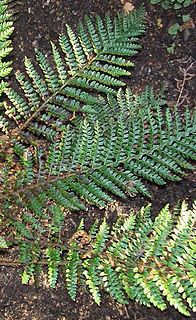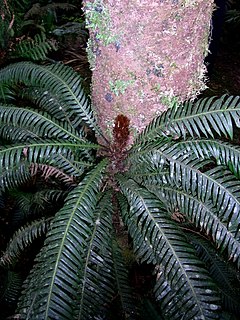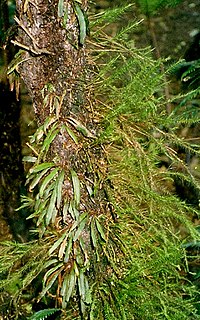
Osmundastrum is genus of leptosporangiate ferns in the family Osmundaceae with one living species, Osmundastrum cinnamomeum, the cinnamon fern. It is native to the Americas and eastern Asia, growing in swamps, bogs and moist woodlands.

Polystichum acrostichoides, commonly denominated Christmas fern, is a perennial, evergreen fern native to eastern North America, from Nova Scotia west to Minnesota and south to Florida and eastern Texas. It is one of the most common ferns in eastern North America, being found in moist and shady habitats in woodlands, stream banks and rocky slopes. The common name derives from the evergreen fronds, which are often still green at Christmas.

Grammitis is a genus of ferns in the family Polypodiaceae, subfamily Grammitidoideae, according to the Pteridophyte Phylogeny Group classification of 2016 (PPG I). It had formerly been placed in the family Grammitidaceae, but this family is no longer recognized by most authors because phylogenetic analyses of DNA sequences have shown that it is embedded in Polypodiaceae.

Asplenium trichomanes, the maidenhair spleenwort, is a small fern in the spleenwort genus Asplenium. It is a widespread and common species, occurring almost worldwide in a variety of rocky habitats. It is a variable fern with several subspecies.

Rumohra adiantiformis, the leather fern or leatherleaf fern, is a species of fern in the wood fern family Dryopteridaceae. It has a wide distribution, mainly in the tropical Southern Hemisphere.

Doodia aspera, commonly known as prickly rasp fern, is a widespread and common plant, growing in eastern Australia. Often seen in rainforest margins or eucalyptus forest in Victoria, New South Wales and Queensland, it is a terrestrial fern with reddish new growth.

Notogrammitis billardierei, the common finger-fern or strap fern is a small fern growing in high rainfall areas of south-east Australia and in New Zealand. A common plant, growing on branches, logs or on rocks in and near rainforest.

Polystichum proliferum, commonly known as mother shield fern is an Australian endemic fern. The genus name Polystichum is derived from Greek poly - many, and stichos - rows referring to the many rows of sori. The species name is derived from Latin, Proli – offspring and fer - bearing referring to the proliferous buds, a prominent feature of the species.

Adiantum hispidulum, commonly known as rough maidenhair fern or five-fingered jack, is a small fern in the family Pteridaceae of widespread distribution. It is found in Africa, Australia, Polynesia, Malesia, New Zealand and other Pacific Islands. Its fronds rise in clumps from rhizomes among rocks or in the soil in sheltered areas.

Adiantum formosum, known as the giant maidenhair or black stem maidenhair is a fern found in Australia and New Zealand. It was one of the many species authored by Scottish botanist Robert Brown, appearing in his 1810 work Prodromus Florae Novae Hollandiae et Insulae Van Diemen. Its species name is the Latin adjective formosus "handsome" or "beautiful".

Lomaridium contiguum, synonym Blechnum contiguum, is a fern in the family Blechnaceae. The specific epithet refers to the contiguous lobes of the fronds.
Cranfillia geniculata, synonym Blechnum geniculatum, is a fern in the family Blechnaceae. The specific epithet refers to the geniculate base of the sterile fronds.

Alsophila ferdinandii, synonym Cyathea macarthurii, is a fern in the family Cyatheaceae.

Polystichum whiteleggei is a fern in the family Dryopteridaceae. A former common name was heavy fern, alluding to the weight of one of the large, thick textured, fronds when fully developed. The specific epithet honours Thomas Whitelegge (1850–1927) of the Australian Museum, who collected zoological specimens on Lord Howe Island in 1887, who first noticed the fern's distinctiveness.

Grammitis nudicarpa is a fern in the family Polypodiaceae.

Grammitis wattsii is a fern in the family Polypodiaceae. The specific epithet honours the Reverend W. W. Watts (1856–1920), a prominent Australian cryptogamist active in the late 19th and early 20th centuries.

Leptopteris moorei is a fern in the family Osmundaceae. The specific epithet honours Charles Moore, Director of the Royal Botanic Gardens in Sydney from 1849 to 1896, who collected plants on Lord Howe Island in 1869.
Tasmania is home to 'Australia’s largest cool temperate rainforests... Most of Tasmania’s rainforests occur in the North-West and throughout the North East highlands. Cool temperate rainforests typically have a heavy rainfall, cool climate, favor high altitudes and have a limited availability of light.

Schizaea rupestris is a small Australian fern. Most populations are in found in the ranges near Sydney. However, it also occurs near Woolgoolga and Western Australia.
















